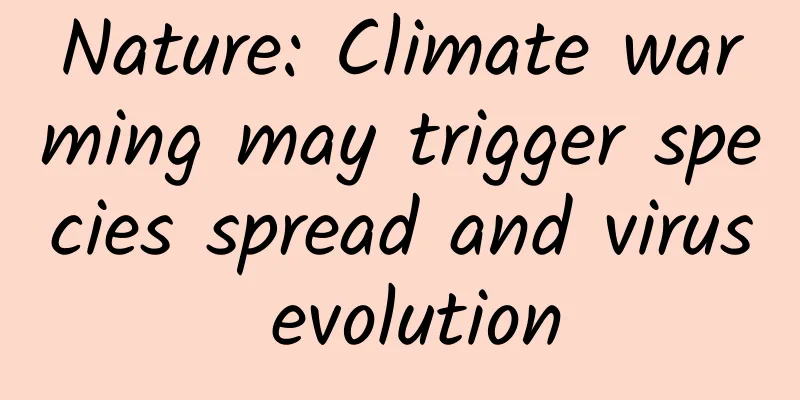Nature: Climate warming may trigger species spread and virus evolution

|
There are at least 10,000 viruses in nature that have the ability to infect humans, but currently the vast majority of these viruses circulate silently among wild mammals. However, if climate and land use change, new opportunities will arise for sharing viruses between previously geographically isolated wildlife species. Recently, a paper published in Nature pointed out that driven by climate change, at least 15,000 new cross-species virus transmissions are expected to occur by 2070. These increased opportunities for virus sharing may increase the risk of new infectious diseases jumping from animals to humans in the next 50 years, especially in Africa and Asia. Researchers predict that as the global climate continues to warm, wild animals with many parasites and pathogens will be forced to migrate their habitats. However, these desperate wild animals are likely to migrate to areas where humans live. This phenomenon will greatly increase the risk of viruses spreading to humans, leading to new epidemic outbreaks. Scientists also note that climate-driven species dispersal and viral evolution may already be occurring. These shifts could lead to the emergence of Ebola, coronaviruses or other new viruses, and make them harder to track and easier for viruses to jump into humans via “stepping stone” species, where pathogens jump from wild animals to humans. “The closest analogy is actually the risks we see in the wildlife trade. We worry about wildlife markets because bringing unhealthy animals together in unnatural groups creates opportunities for this gradual process of viral transmission — just like how SARS spread from bats to civets and then from civets to people,” said Dr. Colin Carlson, lead author of the study and assistant research professor at the Center for Global Health Science and Security at Georgetown University Medical Center. "But now, wildlife markets are no longer special. In a changing climate, these processes have become almost ubiquitous." As the climate warms, many animal species are driven into new environments, taking their parasites and pathogens with them. These geographic migrations may facilitate the exchange of viruses between species that previously had no interaction and could promote zoonotic “spillover,” the transmission of pathogens from wild animals to humans. Prior to this, few studies have assessed how global change might affect potential future hotspots for virus sharing and emerging diseases. In this latest study, Colin Carlson and colleagues examined how the geographic ranges of 3,870 mammal species might change by 2070 under different climate change scenarios. The researchers used a model of mammal virus sharing patterns to predict the chances of future cross-species virus transmission between 3,139 animal species. New encounters between mammal species are likely to occur anywhere in the world, but will be concentrated in areas with high population density in tropical Africa and Southeast Asia. Under a scenario of 2°C warming, it is expected that by 2070, the reorganization of mammal distribution driven by climate change will lead to at least 15,000 new cross-species virus sharing events. Moreover, the study predicts that these new virus sharing events will be mainly driven by bats, which may carry viruses that are easily transmitted to humans. Figure | By 2070, population centers in Africa, southern China, India, and Southeast Asia will overlap with hotspots for cross-species virus transmission in wild animals (Source: GUMC) The work focuses on changes in geographic ranges, which lead to changes in the habitats of different mammals. When mammals of the same species encounter other species for the first time, these geographic migrations may promote the exchange of viruses between species that have previously had no intersection, resulting in them sharing thousands of viruses. And there is concern that animal habitats will disproportionately move into the same places as human settlements, creating new hotspots of spillover risk. Much of this process may already be underway under today’s 1.2°C global warming scenario, and efforts to reduce greenhouse gas emissions may not be able to prevent these events. Another important finding is the impact that rising temperatures will have on bats. Bats are known to be one of the greatest carriers of new viruses, and their ability to fly will allow them to travel long distances and share the most viruses. Due to the central role of bats in the emergence and spread of viruses, the greatest impact of climate change on pandemic outbreaks is expected to be in Southeast Asia, as this is a global hotspot of bat diversity. (Source: Pixabay) "Our simulations blew us away," Carlson said. "We spent years double-checking these results with different data and different assumptions, but the models always led us to these conclusions. This is a pretty amazing example that we can actually predict the future if we try." "This mechanism adds a new dimension to how climate change will threaten human and animal health," said co-lead author Gregory Albery, PhD, a postdoctoral fellow in the Department of Biology in Georgetown University's College of Arts and Sciences. "It's unclear exactly how these new viruses will affect the species involved, but it's likely that many of them will translate into new conservation risks and fuel new outbreaks in humans." Overall, the study suggests that as viruses begin to spread between host species at unprecedented rates, the impacts on human health could be staggering, with climate change emerging as the biggest upstream risk factor for the emergence of pandemics — surpassing high-profile issues such as deforestation, wildlife trade and industrial agriculture. In addition, the study highlights the need to combine virus surveillance with changes in species distribution caused by climate change, especially in tropical regions, which are the cradle of most infectious diseases that can jump from animals to humans. The solution, the researchers believe, is to combine wildlife disease surveillance with real-time studies of environmental changes. (Source: Pixabay) "We are closer than ever to predicting and preventing the next pandemic. This is a big step toward prediction — now we have to start solving the hard parts of the problem," Carlson said. “When Brazilian free-tailed bats travel all the way to Appalachia in the eastern United States, we should invest in understanding which viruses are traveling along as well. Trying to detect these geographic leaps of hosts in real time is the only way we can prevent this process from leading to more spillovers and more epidemics.” “The COVID-19 pandemic, and the previous spread of SARS, Ebola, and Zika, show that viruses jumping from animals to humans can have dramatic effects,” said Sam Scheiner, a program director at the National Science Foundation (NSF), which funded the research. “To prevent them from jumping to humans again, we need to understand their spread in other animals. This study suggests that increased animal movement and interactions due to a warming climate could increase the number of viral jumps between species.” References: https://www.nature.com/articles/s41586-022-04788-w https://gumc.georgetown.edu/news-release/new-study-finds-climate-change-could-spark-the-next-pandemic/ |
<<: To those who spray disinfectant at others, I advise you to be kind!
Recommend
Maximizing the value of the supply chain LePar is not a simple O2O
In the era of Internet TV, LeTV, which uses both ...
How to effectively use tools such as mind mapping to read 150 books in a year?
I have read thousands of books now, and I can cou...
Digital marketing makes business decisions more scientific
Digital marketing refers to a marketing method th...
How much does it cost to create a ticketing app in Shangluo?
In order to better penetrate into various industr...
How to do a good job in marketing and promotion of enterprise apps
With the popularity of smart phones and the rise ...
Cognitive iteration allows you to transition from micro-operation to large-scale operation!
At the beginning of this year, Luo Pang’s speech ...
Practical sharing: 90 upgrades of mini programs, 3 things for operators to think about
From the opening of the mini program internal bet...
Sneak peek at the 618 e-commerce report: advertising increased by about 55% month-on-month, and major information flows have creative pictures!
For online shoppers, there are two opportunities ...
Resembling the Big Dipper! This is the most flaming volcano in the Yitong volcano group!
It turns out that this is the most fiery volcano ...
Lessons from China’s 4G breakthrough
The number of 4G users exceeded 50 million, a goa...
iPad mini has become a "useless" but still indispensable
On October 19, the US technology website Cnet pub...
Narcissus or garlic sprouts? Beware of poisoning if you eat the wrong one!
Audit expert: Li Guangwang Director of the Natura...
Headline delivery: What to do if the account volume is unstable?
1. The account volume is unstable and the planned...
Will Jiangsu officially implement delayed retirement starting March 1, 2022? To what specific age should retirement be delayed? Attached is the latest news on age!
Delaying retirement has been one of the topics th...
Be careful when taking a bath in cold weather! The bathroom heater may turn into a "destroyer"
Take a hot bath in cold weather It is undoubtedly...









